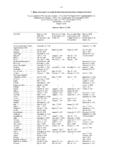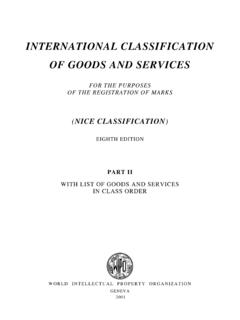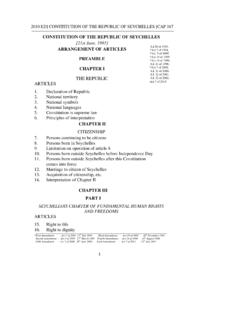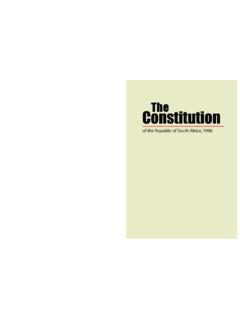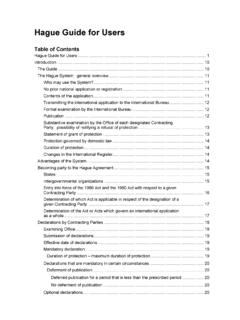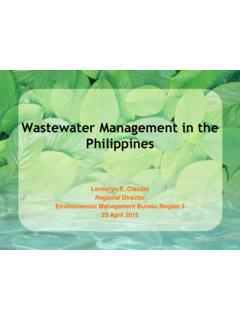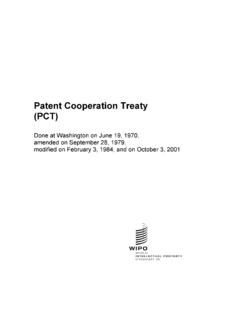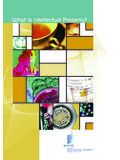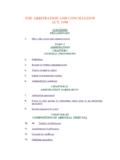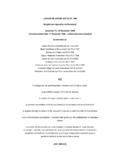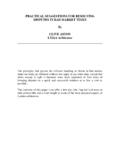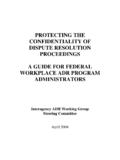Transcription of 2-25 IP LITIGATION COSTS SPECIAL EDITION
1 IP LITIGATIONCOSTSWIPO S NEWTOP MANAGEMENT262-25 GENEVA FEBRUARY 2010 EDITIONNew Partiesto WIPO Administered Treaties in 2009 During 2009, 68 instruments of accession or ratification of treaties administered by WIPO weredeposited with the Director General of WIPO. The treaties and new adherents are as follows:In the field of industrial propertyPatent Cooperation Treaty (PCT) (1970) Chile, Peru and Thailand (3), bringing the total numberof States to Madrid System for the International Registration of Marks (Madrid Agreement (1891) andMadrid Protocol (1989)) Egypt, Liberia and Sudan (3) adhered to the Madrid Protocol, bringing the totalnumber of States/IGOs to Law Treaty (TLT) (1994) Morocco, Nicaragua and Peru (3), bringing the total number ofStates to Treaty on the Law of Trademarks (2006)
2 Estonia, France, Liechtenstein, Mali, Netherlands(The Netherlands will become bound by the Treaty three months after the deposit of the instruments ofratification of Belgium and Luxembourg), Poland, Russian Federation and Spain (8), bringing the total number of States to 17. Strasbourg Agreement Concerning the International Patent Classification (1971) Serbia andUkraine (2), bringing the total number of States to Agreement Establishing an International Classification for Industrial Designs (1968) Argentina and Ukraine (2), bringing the total number of States to Agreement Establishing an International Classification of the Figurative Elements ofMarks (1973) Serbia and Ukraine (2), bringing the total number of States to Agreement Concerning the International Registration of Industrial Designs Germany,Poland and Serbia (3)
3 Adhered to the 1999 Geneva Act of the Hague Agreement, bringing the total number ofStates/IGOs to Law Treaty (PLT) (2000) France, Liechtenstein and Russian Federation (3), bringing the totalnumber of States to the field of copyright and related rightsWIPO Copyright Treaty (WCT) (1996) Austria, Bosnia and Herzegovina, Denmark, Estonia, EuropeanUnion, Finland, France, Germany, Greece, Ireland, Italy, Luxembourg, Malta, Netherlands, Portugal, Spain,Sweden, Tajikistan, United Kingdom and Uruguay (20), bringing the total number of States/IGOs to Performances and Phonograms Treaty (WPPT) (1996) Austria, Bosnia and Herzegovina,Denmark, Estonia, Finland, France, Germany, Greece, European Union, Ireland, Italy, Luxembourg,Malta, Netherlands, Portugal, Spain, Sweden and United Kingdom (18), bringing the total number ofStates/IGOs to for the Protection of Producers of Phonograms Against UnauthorizedDuplication of Their Phonograms (1971) Bosnia and Herzegovina (1), bringing the total numberof States to LITIGATION COSTS AN CONTINGENCY FEES A LEVEL PLAYING FIELD?
4 THE UK: CAN A HIGH- cost COUNTRYCHANGE ITS WAYS?AN EU COMPETITION LAW PERSPECTIVE ON REVERSE PAYMENTSA SINGLE PATENT COURTFOR EUROPE: DREAM OR REALITY?IP LITIGATION IN AFRICARESOLVING IP disputes IN JAPAN COUNTING THECOSTA cost -EFFECTIVEALTERNATIVEKEEP IT CHEAP TEN TIPS FOR MINIMIZING COSTSINTRODUCING WIPO S NEW TOP MANAGEMENT TEAM2369121416192326 CONTENTSGENEVA, FEBRUARY 2010 WIPO MAGAZINE ISSUE 2010/1 World Intellectual Property OrganizationEditor:Sylvie CastonguayGraphic Designer:Odile ContiCover imageiStockphotosAcknowledgementsIgnacio de Castro andSarah Theurich(WIPO Arbitrationand Mediation Center), p. 19 WIPO ContributorsHeike Wollgast, Enforcement and SPECIAL Projects Division,p.
5 2 Berly Lelievre-Acosta, WIPO Arbitration and MediationCenter, p. 19IP LITIGATION COSTS 2 FEBRUARY 20101 For details of the caseand the settlementagreement see WIPOM agazine 2/2006 Copyright in theCourts: The Return ofthe Lion 2 Working documents ofthe meeting, as well asthe chair s conclusions,are available LITIGATION COSTS AN INTRODUCTION lution models (see A cost -Effective Alternative onpage 19) or simplified procedures, especially in thefield of border enforcement. Emphasis was placedon mechanisms to reduce LITIGATION COSTS for par-ties in need, including legal aid, or provision for liti-gation on a pro-bono basis. In that regard, refer-ence was made to South Africa where the barassociation requires its practicing members to con-duct a certain number of pro-bono cases per year,thereby supporting public interests and certainprovisions of the Bill of approach suggested was the conductingof LITIGATION on a contingency basis (see Fees: A Level Playing Field?)
6 On page3). Obviously, such a model could only be attractivein the case of LITIGATION seeking monetary payment,as opposed to injunctive relief. With that in mind,another suggestion was proposed: establishingstate-administered funds for instituting IP funds, it was argued, could be derived fromregistration fees. More broadly, the Committeelooked at pre-emptive measures as a possiblemeans of controlling enforcement COSTS . The sug-gestions in that respect touched on defining tradepolicies and business models so as to diminishthe demand for counterfeit goods and bringingprices into a more balanced alignment.
7 The ACE, an advisory body with no norm-settingmandate, is a forum for exchanging information anddoes not work towards binding solutions on any ofthe matters it addresses. Discussions neverthelessclearly revealed that overly expensive IP LITIGATION is aserious concern in many countries, and is perceivedto have negative effects on effective law enforce-ment and the acceptance of the IP system in general. This issue of the WIPO Magazine on IP LitigationCosts addresses the aforementioned challenges inIP LITIGATION and looks in particular at the COSTS andparticularities of IP dispute resolution in jurisdictionssuch as Africa (page 14), Europe (page 6 and 12),Japan (page 16) and the (page 3).
8 The WIPOA rbitration and Mediation Center, co-editor of thisissue, explains the benefits of Alternative DisputeResolution (page 19), which appears to be an effi-cient way out of costly and complex IP , a range of useful practical tips are providedfor minimizing IP dispute settlement COSTS (page 23).The settlement of the famous 2006 The LionSleeps copyright case with its happy ending forthe heirs of the author was widely reported in thepress and celebrated as an example of successfuluse of the intellectual property (IP) system in ensur-ing remuneration of should, however,be kept in mind that this case was exceptional inmany respects, including the funding of the litiga-tion.
9 Given the song s popularity and its cultural im-portance, the institution of the case benefited fromsignificant financial sponsoring. In reality, for mostlitigants, one of the greatest obstacles associatedwith IP LITIGATION is high, if not excessive, COSTS . To what extent does the situation prevent rightholders from taking legal steps against infringe-ment? Do high LITIGATION COSTS fuel a perception,more generally, that the IP system only benefitswealthy or large companies equipped with expen-sive legal expertise? And, against that background,in what possible ways could high LITIGATION COSTS beaddressed in the broader context of an enablingenvironment within which IP rights are respected?
10 These were among the thorny questions addressedat the November 2009 session of the WIPOA dvisory Committee on Enforcement (ACE). TheCommittee, composed of WIPO Member Statesand accredited observer organizations, focused itsdiscussions on Contributions of, and COSTS to, rightholders in enforcement, taking into considerationRecommendation No. 45 of the WIPO DevelopmentAgenda. The Committee discussed issues, based onexpert analysis presented, including the reasons forthe high COSTS of IP LITIGATION , especially for litigantsin developing countries, and looked at suggestionsfor making the system more attorneys fees were viewed with concern.
